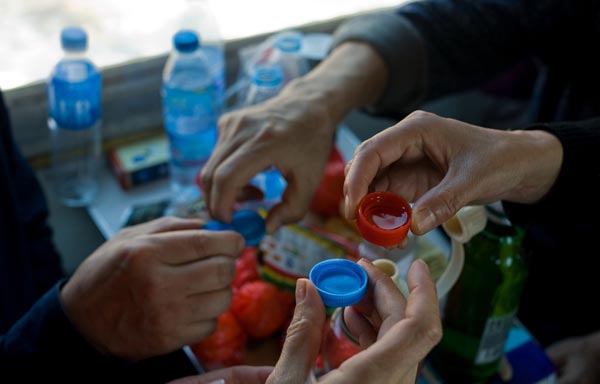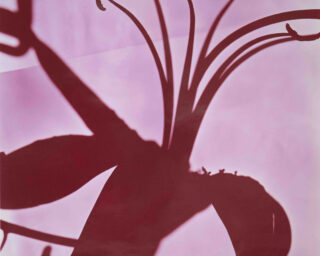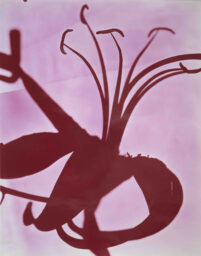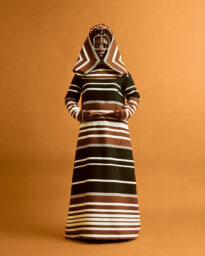Expanded Geographies
At the LianzhouFoto Festival, photographers remap the world with images from near and far.

Billboard for Expanded Geographies, Lianzhou, China, 2015
To travel through China for the first time and attempt to focus on anything other than being in China for the first time is a thrilling challenge. I discovered this in November when I had the opportunity to attend the 2015 LianzhouFoto Festival. Lianzhou is a rapidly growing city in the northwest province of Guangdong, accessible only by a four-hour bus ride northwest of Guangzhou. In the weeks before leaving, I sat in my apartment in New York Googling images of the area. The results yielded both tourist attractions like the illuminated, jewel-toned underground river located just outside the city limits and iconic images by leading international photographers—Martin Parr’s tourists basking on the beach in Benidorm, Spain; Ren Hang’s seductive, tangled nudes; or Arno Rafael Minkkinen’s hand, staged as a bird floating over mountains. The latter images were associated with Lianzhou, which since 2005 has become a destination for its internationally recognized photography festival.
The theme and title for LianzhouFoto 2015, curated by Christopher Phillips of the International Center of Photography in New York, was Expanded Geographies. Meant to explore “the emerging connections between different parts of the globe,” as Phillips wrote in his curatorial statement, the festival was mounted in three main venues across Lianzhou—a former candy factory, granary, and shoe factory. Because of the international scope of the work, the most striking thread to pull from the curated exhibitions was, as Phillips intended, the similarities between seemingly disparate bodies of work from around the world. At the festival, this was acutely evident in the parallels between images in an exhibition called The Chinese Photobook and an installation of Kodak Coloramas.

The Chinese Photobook, Installation view at LianzhouFoto Festival, 2015
Released by Aperture in the spring of 2015, The Chinese Photobook: From the 1900s to the Present explores China’s history through the publication of photobooks from the 1900s to the present. At the candy factory in Lianzhou, selected content from the book was exhibited in the form of large posters displaying covers and interior pages, along with physical books in glass vitrines. One of the most captivating sections was Happy Youth of China, published in 1955 by China Youth Press Beijing, showcasing staged, joyful kids playing at the beach, on the farm, or posing as they ride horses. In the pages of Guizhou, published by Guizhou People’s Publishing House, a fit young man plays the accordion on the shore of a beach as a group of women swim and gossip in the background. Gu Zheng, a contributing writer for The Chinese Photobook, explains that the relationship between China’s sociopolitical climate and the design and content of the “propagandistic” photobooks during this period: “Since the books emphasize nation building and the prosperous lives of ordinary citizens, their editorial style tends to be clean and legible, with carefully managed compositions and placements of human subjects.”
These staged images of everyday, happy Chinese citizens stayed with me as I left the candy factory and walked through the market to the next venue, where I visited the exhibition organized by Musée Nicéphore Niépce. The museum’s expansive collection of Kodak Coloramas—staged panoramic photographs from the U.S. taken between 1950 and 1990—filled the walls of a former shoe factory. Image after image reflected Kodak’s theatrical and highly polished vision of the post-war American dream: panoramas of largely white, middle class, young families or couples in pastoral landscapes, smiling and posed almost as if they were wax figurines. Viewing Coloramas in China, in a setting curated to encourage the comparison of geographies and ideologies, it became disarmingly clear that the nationalist propaganda by Mao-era photobooks was nearly identical to the American Colorama campaign of the 1950s and ’60s.

Happy Youth of China, China Youth Press Beijing, 1955

Herbert Archer, Lobsters bake, Acadia National Park, Maine, 1963 © Eastman Kodak Co.
On display in the same room as the Kodak Colorama, Catherine Leutenegger’s series Kodak City (2014), which profiles the collapse of the Kodak empire in Rochester, New York, exposed the other—perhaps more accurate—view of an American reality: the remains of a city once home to a prosperous and iconic industry. In the granary, Guy Tillim’s Avenue Patrice Lumumba (2007–8) offered a disquieting vision of postcolonial African architecture, built in the optimistic era of independence, but now in varying states of decay. Pablo Lopez Luz, concerned with overpopulation and the speed of development, captured a swiftly changing and entirely new topography of Mexico City in his series Terrazo (2011–15). His photographs of infrastructure and development—whether collapsed or collapsing, abandoned or booming, frozen in time, or newly developed—prove that modernization holds the spotlight as a globally pervasive and timely photographic subject.
Other photographic themes in the LianzhouFoto festival highlighted environmental disaster, as seen in the photographs of flood survivors in Gideon Mendel’s ongoing Drowning World project. Lisa Barnard’s series Hyenas in the Battlefield (2014) powerfully emphasizes the complexity of modern-day conflict, memory, and trauma. Dru Donovan, in her exploration of identity and self-image, presented black-and-white photographs of teenagers, young adults, and individuals altering their bodies.
Despite the riveting overlaps to be found in the internationally oriented selections, I gravitated toward work documenting contemporary China. For this reason, I was pleased to come across an exhibition by Qian Haifeng in the shoe factory. Brought to Lianzhou by curator Tang Wuhao, Haifeng works as an electrician at the Wuxi Grand Hotel. For over seven years, on weekends and in his time off, Haifeng has taken over 150,000 photographs while riding the national train system. His series documents families with babies, sleeping workers, solitary teenagers, and travelers who temporarily set up camp and makeshift living rooms as they travel throughout China.

Qian Heifeng, The Green Train, 2007–15 © the artist
Focusing within this specific, fixed environment—the train cars are green, with a mustard-yellow stripe along the sides—Haifeng’s images capture poverty, humor, conflict, and unstaged daily life on the road. The exhibition included a map drawn on the wall to outline the expansive network of train routes crossing all corners of the country; alongside each photograph was the ticket purchased for that given ride. During the festival, Mr. Haifeng received the Punctum Prize. In his acceptance speech, he poignantly described his connection to the project: “I belong to the same group as those people on the train and, though I am not a professional, I just want to preserve each moment that reflects our daily life.”

Qian Heifeng, The Green Train, 2007–15 © the artist
To accompany such contemporary views of China, Swiss photographer Walter Bosshard’s photographs of China from 1933 and 1939 provided a fascinating visual history. In May 1938, Bosshard traveled with the American journalist Archibald T. Steele to the mountains of the Shensi Province to visit Mao Zedong. They were the first foreign correspondents to interview Mao in the remote area, and, in addition to the photographs, they produced a silent film capturing their journey. Included in the film was footage of the Chinese countryside from their travels to the mountains in the west. After the festival, as I thought about those images on the bus returning to Guangzhou, I looked out the window at a landscape transformed—and I wondered if Bossard would recognize the country today.


























